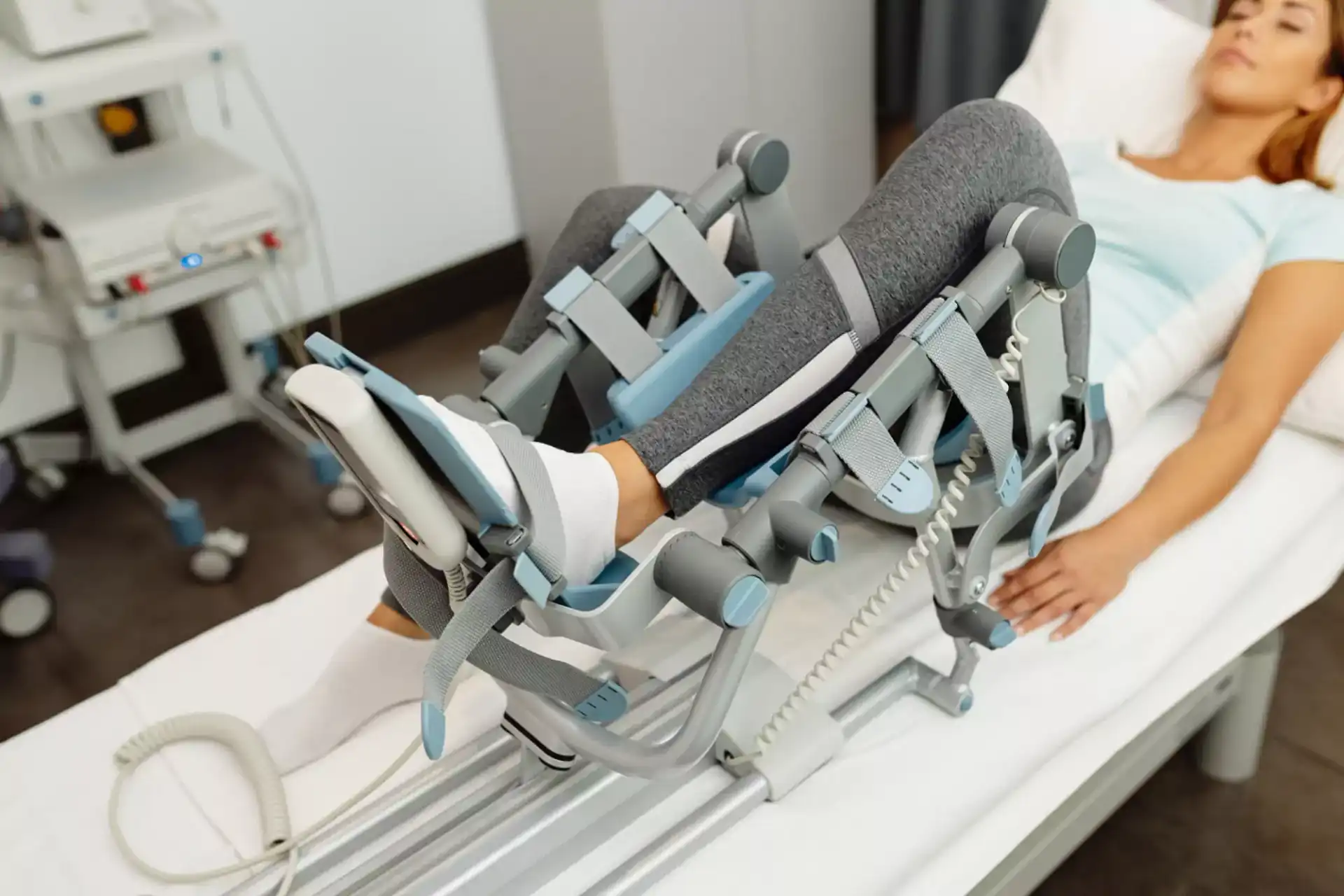Post-Knee Surgery Workouts to Strengthen Your Knee and Improve Mobility

After knee surgery, whether it’s knee replacement or arthroscopy, the main focus is on rest and healing. But did you know that engaging in the right exercises can speed up your recovery? Research shows that post-knee surgery workouts may help improve circulation, build strength, and increase mobility—helping you get back to daily activities faster.
In this guide, we’ll walk you through the most effective exercises for post-knee surgery recovery, when to perform them, and how they help at each stage of your recovery. We’ll also go over precautions to ensure your workouts are safe and effective.
Why post-knee surgery workouts are important?
Rest and medicine are important for recovery, but movement is just as vital. Doing the right exercises after surgery can help reduce swelling, improve blood flow, prevent muscle weakness, and make your knee more flexible. They also build strength in the muscles around your knee, which helps with stability.
However, it’s important to take it slow and choose the right exercises for each stage of recovery. This way, you can heal safely and get back to your daily activities faster.
What are some popular post-knee surgery workouts?
Below are some common and effective exercises to include in your recovery plan after knee surgery. These workouts help improve strength, flexibility, and mobility.
1. Walking
Walking is one of the most effective ways to help your knee heal after surgery. In the early stages, you’ll likely use crutches or a walker for support. As your strength improves, you'll gradually be able to put more weight on your leg and eventually walk without any assistive devices.
Here are some tips for walking:
- Take it slow and steady. Start by walking at a comfortable pace, making sure your knee stays straight as you take each step.
- Increase distance and speed gradually. As your strength improves, you can slowly increase both the length and speed of your walks to build endurance and mobility.
2. Ankle pumps
Ankle pumps are a simple yet effective way to promote circulation and reduce swelling, especially in the early stages of recovery.
Here’s how to do it:
-
Lie down with your legs straight.
-
Move your foot up and down, engaging your calf and shin muscles.
-
Do this exercise for 2-3 minutes every hour, especially during the early days after surgery.
3. Quadriceps sets
Strengthening the quadriceps is important for knee stability. This simple exercise helps activate the quads without straining the knee joint.
How to do it:
-
Sit on the floor with your injured leg straight out in front of you.
-
Tighten your thigh muscle (quadriceps) and try to press the back of your knee toward the floor.
-
Hold for 5 seconds, then relax.
-
Repeat 10-15 times, gradually increasing the duration as strength improves.
4. Straight leg raises
Straight leg raises help strengthen the quadriceps without putting pressure on the knee joint.
How to do it:
-
Lie down on your back, keeping one leg straight and the other bent.
-
Tighten the muscles on your straight leg and slowly lift it several inches off the ground.
-
Pause for a moment, then bring it down slowly.
-
Repeat 10-15 times.
5. Step-ups
Step-ups help improve balance and strengthen muscles around the knee.
How to do it:
-
Stand in front of a low step or platform.
-
Step up with your non-injured leg, then bring your injured leg up to meet it.
-
Step down with your injured leg first, then follow with the other leg.
-
Repeat 10-15 times.
6. Exercycling
Cycling is a great way to improve knee mobility and muscle strength.
How to do it:
-
Start with light resistance and pedal backward for a few minutes.
-
Gradually increase resistance as you gain strength.
-
Aim for 10-15 minutes of cycling, 2-3 times a day.
7. Bed-supported knee bends
This exercise helps to improve knee flexibility by gently bending the knee joint.
How to do it:
-
Lie on your back and slide your foot toward your buttocks to bend your knee.
-
Hold for 5-10 seconds, then straighten your leg.
-
Repeat until you can bend your knee further with each session.
8. Sitting knee bends
Sitting knee bends also target knee flexibility and mobility.
How to do it:
-
Sit on a chair with your feet flat on the floor.
-
Slowly slide your foot back toward your buttocks, bending your knee as much as you can.
-
Hold for 5-10 seconds, then straighten your leg.
-
Repeat until you can bend your knee further.
9. Standing knee bends
Standing knee bends help strengthen the muscles around your knee and improve your ability to bend the knee.
How to do it:
-
Stand with support (such as a wall or sturdy chair).
-
Bend your knee as much as possible, hold for 5-10 seconds, then straighten your leg.
-
Repeat 10-15 times.
10. Resistance training
Adding light resistance to exercises can help further strengthen the muscles around your knee and improve stability.
How to do it:
-
Start with light ankle weights (1-2 pounds) and perform exercises like straight leg raises, step-ups, and knee bends.
-
Gradually increase the weight as you get stronger.
Want knee surgery and a recovery workout plan? Contact QCG to find affordable surgery options and post-surgery fitness support.
How can workouts be adapted for different recovery phases?
Post-knee surgery recovery is typically divided into phases, each with different goals and exercises. Here's a breakdown of what kind of exercises should be done during each stage:
Early recovery (Weeks 1-3)
The focus is on reducing swelling, improving circulation, and regaining gentle movement. In this phase, exercises like ankle pumps, quadriceps sets, and walking (with support) are appropriate.
Mid-term recovery (Weeks 4-6)
This phase focuses on strengthening muscles and improving flexibility. You can include exercises like straight leg raises, step-ups, sitting knee bends, and bed-supported knee bends.
Advanced recovery (Weeks 7-12)
The goal is to build endurance, strength, and knee stability for more demanding activities. During this phase, include exercises like exercycling, standing knee bends, and resistance training.
Long-term recovery (3+ months)
In this phase, the goal is to maintain strength and mobility while gradually returning to normal activities. Continue with standing knee bends, resistance training, and regular walking.
Precautions you must take while doing any exercise
Exercising after knee surgery can speed up your recovery, but it’s also important to take a few precautions to avoid setbacks or injury:
-
Listen to your body. If you feel pain (more than just mild discomfort) or notice extra swelling, stop and talk to your doctor.
-
Don’t rush. Take your time as you go through each recovery phase. Pushing too hard too soon can lead to strain or re-injury.
-
Focus on proper form. Make sure you’re doing the exercises the right way. If you’re not sure, ask your physical therapist for help.
-
Avoid high-impact activities. Skip activities that put a lot of pressure on your knee, like running or jumping, until your doctor or therapist gives you the green light.
-
Stay consistent. Stick to your exercise plan, but don’t overdo it. Rest is just as important as exercise for healing.
-
Listen to your doctor. Before trying any new exercises, make sure to check with your physical therapist or doctor, especially if you're facing any recovery challenges.
Bottom line
In a nutshell, post-knee surgery workouts are essential for achieving a full recovery. By incorporating safe, effective exercises into your recovery plan, you can regain strength, flexibility, and mobility more quickly. Be patient, and don’t rush the process. As you progress through each phase of recovery, you’ll gradually build up strength and return to your normal activities. Always listen to your body, and consult your healthcare provider before starting any new exercise.
Searching for affordable knee surgery with a fitness plan? Get in touch with QCG to discover top international hospitals and clinics offering knee surgery and expert recovery workouts.

